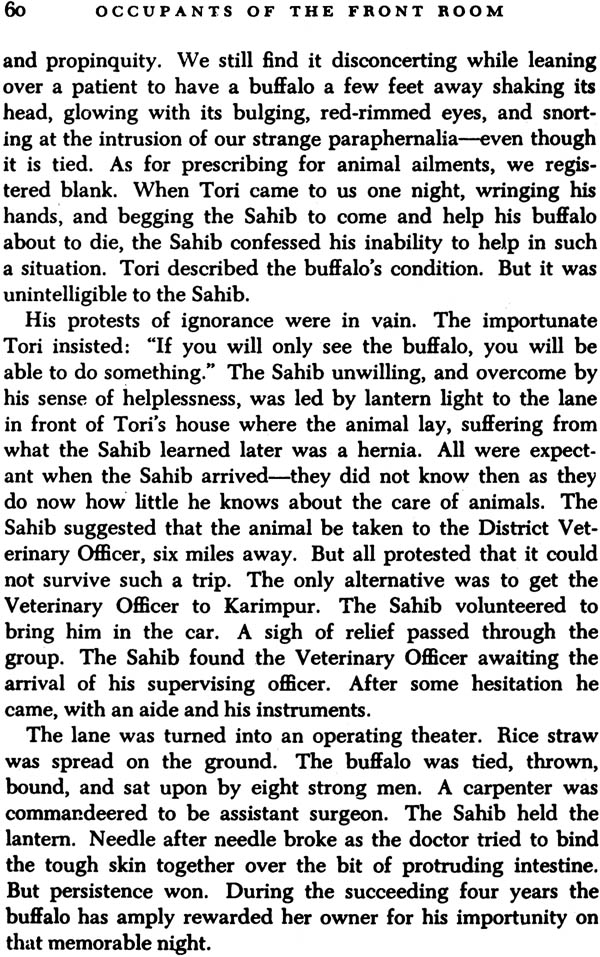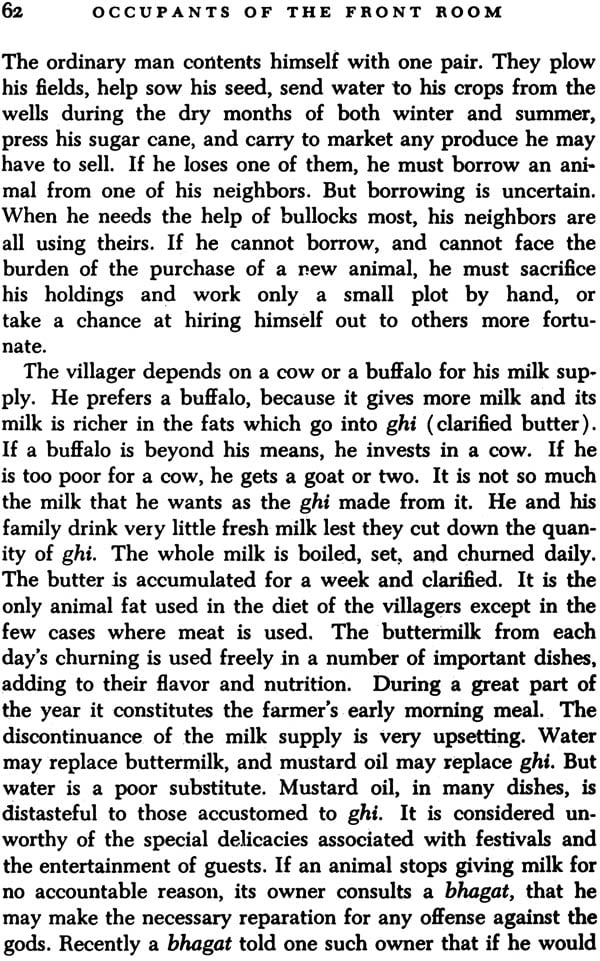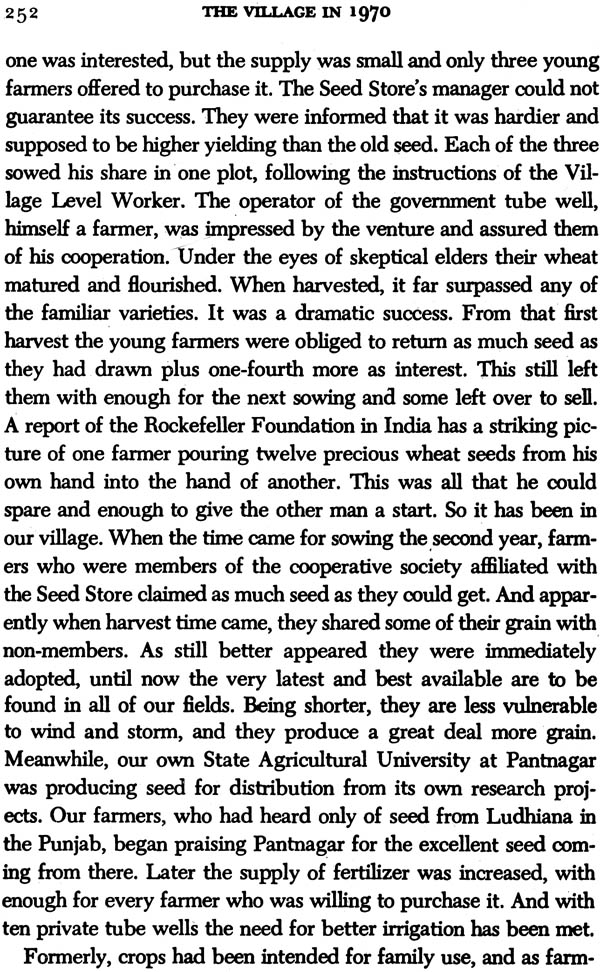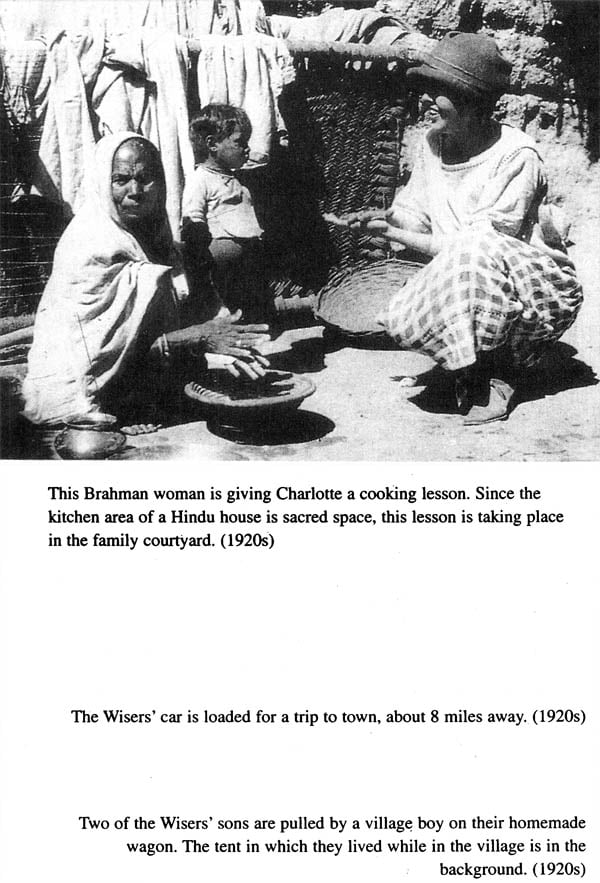
Behind Mud Walls (Seventy-Five Years in a North Indian Village)
Book Specification
| Item Code: | NAH134 |
| Author: | William Wiser and Charlotte Wiser |
| Publisher: | Chronicle Books, New Delhi |
| Language: | English |
| Edition: | 2001 |
| ISBN: | 8180280128 |
| Pages: | 408 (21 B/W Illustrations) |
| Cover: | Hardcover |
| Other Details | 8.5 inch x 5.5 inch |
| Weight | 630 gm |
Book Description
In 1925, William and Charlotte Wiser arrived in the North Indian village of Karimpur. Over the next five years, they wrote one of the first studies of village India, originally published in 1930. Charlotte Wiser continued to observe and write about the village until her death, when Susan Wadley picked up the narrative. With updates from the 1960s, 1970s, 1984, and 2000, this expanded edition now encapsulates seventy-five years of continuity and change in the village.
The book traces the initial awkwardness between the Wisers and the villagers and the years of friendship and welcome that followed. It sketches the social and economic changes brought on by the increasing encroachment of the outside world and describes the day-to-day life of people who live in the village-the education of the young, women's lives in the courtyard, castes and the loss of the jajmani system, the changing patterns of marriage, family, and occupation, including the effects of the green revolution in the 1970s and the more recent shift to men (and sometimes unmarried girls) seeking jobs in Delhi and other nearby cities.
Karimpur has changed vastly in the seventy-five years since the Wisers first described it and Wadley's two updates portray a world that would have been unimaginable in the 1920s. Whether a rejection of purification of ritual space by cow dung or unmarried daughters in their 20s or girls working in telecom factories in Delhi, the changes are profound and shed light on social change in rural India.
William and Charlotte Wiser were missionaries who first travelled to India in the 1920s. They set up Indian Village Service, a community oriented Village Service, a community oriented village development organization that became one of the key models used by the Indian government for its Block Development Programs.
When we came to Karimpur five years ago, to make a survey of the social, religious, and economic life of a fairly typical North India village, we were bent upon gathering facts by the most direct methods possible. But our new neighbors were not prepared for anything so rapid or impersonal. They refused to help us by any route other than the leisurely one of friendship. The result was that we became engaged in numerous neighborly activities which often led us out of sight of our survey, but which we could not conscientiously refuse. We had learned from our neighbors that the road of friendship and service is courteous and just, if not the most efficient. Those who expected a routine survey-as we did when we started out-gave us up long ago as hopelessly enchanted.But the information collected with the help of our village friends, is a document which we hope will be of some value as source material.
Many of our experiences along the way have been too personal to have a place in a survey. Yet they are too revealing to be discarded. We have set some of them down in this volume for the friends, both Indian and foreign, who have asked us repeatedly to share our village experiences with them. This informal presentation may be more interesting, and perhaps more helpful, than the detailed information of a survey. We have limited ourselves to those experiences which helped us most to understand our villageneighbors, and those' which were most challenging. We have included the latter that they might in turn challenge the young men and. women, many of whom we know, who because of special training and gifts, or because their fathers own villages, are peculiarly fitted to serve village folk if they choose. As in other countries, interest in rural problems is growing rapidly in India. Since our coming to Karimpur, a number of training schools and institutes for prospective rural workers have sprung up; and there have been an increasing number of speeches and articles on the needs, the conditions, and the handicaps of the peasant. We want to use whatever influence and knowledge we have to encourage a healthy growth of interest based on careful study rather than on sentiment.
A mistake which most of us have made when we have gone straight from our town environment to the village is that we have expected villagers to react like college graduates or sophisticated town dwellers. We have criticized them when they have fallen short of our expectations, while the fault lay with us. Gradually we have learned what others before us have learned, that the ordinary village farmer is the victim of circumstances, not the master. His life is pervaded and pressed down by his fears of the forces which control him. Before we can do much to help, we must consider the source, the power, the utility or harmfulness, of these forces. The maladjustments which many of us have caused in the past, when we were sincerely trying to help, have been due to our consideration of the villager as a free individual, and our oversight of the circumstances which dominate his life.
Although this book is much more personal than our survey, still we have striven to keep it impartial. We have written nothing we would hesitate to write about our own community or our own family. When one of us has been tempted to wax romantic or condemnatory, the other has followed after with a firm blue pencil and has cut down effusions to prosaic facts. We realize that conditions vary greatly in living, as in language or diet or architecture, in different parts of the country and sometimes in different areas of the same province. All we can say is that we know these things to be true of our village. Friends in nearby sections of this province have said that some of our experiences are so much like theirs that they might be their own; whereas a friend from Madras remarked that if he did not know us so well he might doubt our veracity! Whether the material herein presented be of interest because of its contrast or its similarity, we hope that it will be provoocative of further observation and thought and service.
We acknowledge our thanks to the friends and relatives who have made our prolonged stay in the village possible. We are grateful to our Mission for being so long-suffering while we made no apparent progress. We also wish to thank friends who have criticized this material and helped make more readable. And we express our gratitude to our village neighbors, who have been hospitable, generous, and sympathetic, even in times when we have been most trying.
The Wisers first came to Karimpur, a village east of Agra, to do a brief statistical survey. They remained for five years to write a human document. When their book appeared in 1930 it was one of the few accounts of village life in India as seen by sympathetic observers who knew the villagers as friends and neighbors.
Thirty-two years later, after a new generation had come of age, Charlotte Wiser wrote the additional chapters, telling of her return to her friends in Karimpur and of their lives in the new times. When first she saw the village, its older people had grown up in the nineteenth century, when imperial rule was firm, unchallenged, and quite distant from everyday village affairs. Its youngsters now will reach into another century and are already living in a time when the village is much more closely linked to the larger world. This augmented edition of the book is unique in that it shows the people of an Indian village as seen by the same friend after three decades.
The Wisers are to be counted among those missionaries who have made notable contributions to anthropology. They knew well that anyone who works to help villagers must first understand what village life is really like if the work is to be effective. William H. Wiser, who died in 1961, wrote illuminatingly about the relations between families of different castes in his monograph, The Hindujajmani System (Lucknow Publishing House, 1936). He and Mrs. Wiser were among the pioneers in working out the approaches to village development which are today being used throughout India and beyond India. Their efforts in the India Village Service and in teaching about rural realities entered into the shaping of the great Indian government movement for community development.
That movement has brought changes into Karimpur whose full effect is only gradually being felt. Mrs. Wiser finds that in most outward aspects the face of village life is much the same as it was. The daily round is little changed as is the villagers' absorption with their fields and with the tight world of the village and neighborhood. The animals are still quartered in the house or compound. The tasks of the women have altered very little; they still spend long hours in the kitchen enveloped in smoke from the chimneyless hearth.
In deeper respects also, the foundations of village society have not been altered. The family is still the main center of each person's interest and has unquestioned first claim to his loyalty. If there is any choice between family obligations and personal or community advantage, the family comes first. Kinship ties count heavily, even to affecting army recruitment. Caste still separates one village group from another in social relations, and still provides the organizational frame for economic relations. The fundamental concept of society is an hierarchical one. Villagers are zealous to maintain, if possible to advance, their group's status. They must ward off any upward mobility by lower groups which might impugn their own social rank. All villagers can unite in common defense, asthey did in protesting a tax assessment, but concerted action for village improvement is still apt to be thwarted by factionalism; if one side is for something, the other is likely to be against it.
Religion continues as a central fact of village life. Religious observances are part of one's daily life, indicate the main occasions in each person's life cycle, provide the principal markers of accomplishment in the yearly round. More than that, the main savor of village life comes in the setting of religion. Mrs. Wiser mentions taking a truckful of villagers to the nearest place of pilgrimage on the Ganges and notes, "I have never seen a happier crowd." Many others of the familiar, traditional ways continue to bring satisfaction and reward.
Yet the impact of the new ways is apparent and can be summed up in a sentence from the talk with a group of young men, "We have more to eat and more to sell." The villagers now raise hardier, more productive varieties of crops, and the animals are better than they were-a particularly noteworthy advance because, as the Wisers noted in 1930, improvement of the livestock was basic to the improvement of village economy. Farming has become more productive and less uncertain through the use of fertilizers, improved implements, tube-well irrigation. Better roads and bus service have made marketing trips to town easier and more frequent. Transportation greatly improved with the increase of bicycles in the village from two to fifty-six. Owning a bicycle brings some prestige to a villager; more importantly it is a machine that is of considerable economic importance.
A main advance has been in medical care. It was the simple, yet effective, medical aid which the Wisers gave that opened doors to them when they first came to Karimpur. Medical and hospital services outside the village were not then trusted. Now all who are sick are taken to town for medical treatment if they can afford it. Malaria has been much reduced, though other public health measures have not yet taken hold. The net result of better health care and more food is clearly demonstrated by the growth ofKarimpur's population from 754 to 1129 in the three decades, an increase of 49 percent. This increase slows the benefit of the other gains, because the same lands must now be made to support all these additional people, half as many again as there were thirty years ago.
New crops, new techniques, population spurts have all affected village life before these decades, indeed long before this century.But never before have they come so rapidly and with such cumulative effect. An important element in the new wave is a social invention in public administration, the Community Development Program. It is a novel kind of bureaucracy for India, dedicated to culture change, designed to provide communication between village and research station Its officers do not have to cope with the usual tasks of maintaining society and government; the established governmental organizations do that. It attracts into its ranks many among the educated who sincerely want to devote themselves to helping their countrymen. The people of Karimpur know the program through their gram sevak, "village companion," the official who is at the base of the bureaucracy's hierarchy and on whom the success of the program in anyone village largely depends.
Karimpur's village companions have achieved marked success with their farming demonstrations, but have been able to accomplish much less where their suggestions for change touched domestic routine and relations among people. The slower response in matters of social organization is not unusual in the history of mankind-social patterns are generally less amenable to change than technological patterns. Social improvements desired by many villagers and by officials alike are not yet within grasp, but the villagers' view, as Mrs. Wiser communicates it, is undespondent: "All are surprised that so much has been done in so short a time."
| Foreword | vii | |
| Preface to the 2000 edition | xv | |
| Preface to the 1989 edition | xix | |
| Preface to the first edition, 1930 | xxi | |
| BEHIND MUD WALLS1930-1960 | ||
| I | Friend or foe? | 1 |
| II | The leaders | 14 |
| III | Those who follow | 28 |
| IV | The untouchables | 39 |
| V | Occupants of the front room | 59 |
| VI | In family courtyards | 72 |
| VII | The younger generation | 87 |
| VIII | Agents of authority | 100 |
| IX | "Let all things old abide" | 115 |
| X | Return .to the familiar | 135 |
| XI | The new | 160 |
| XII | The young men speak | 213 |
| THE VILLAGE IN 1970 | ||
| XIII | The village in 1970 | 238 |
| XIV | Postscript | 273 |
| THE VILLAGE IN 1984 | ||
| XV | The village in 1984 | 279 |
| THE VILLAGE IN 1998 | ||
| XVI | The village in 1998 | |
| Appendix: demographic tables | 341 | |
| Appendix: photographs | 347 | |
| Bibliography | 365 | |
| Glossary | 369 | |
| Index | 377 |





















